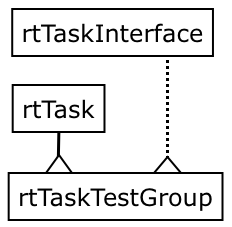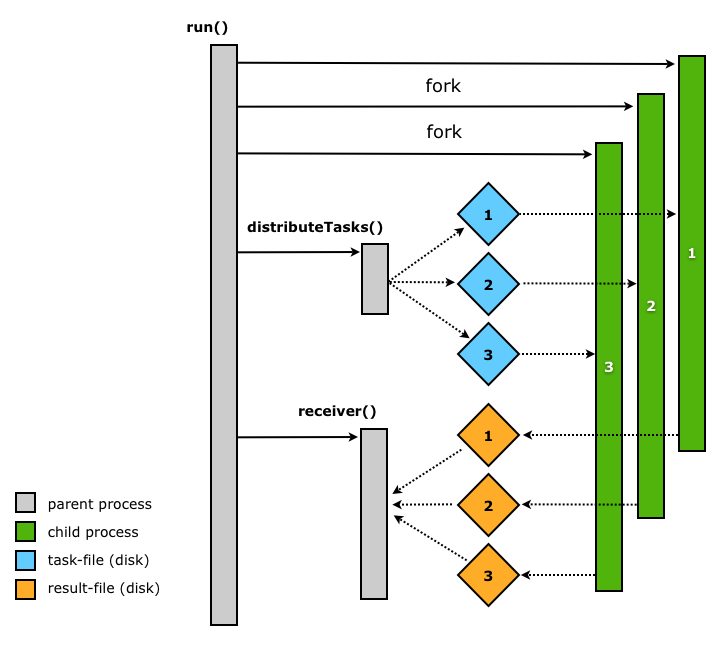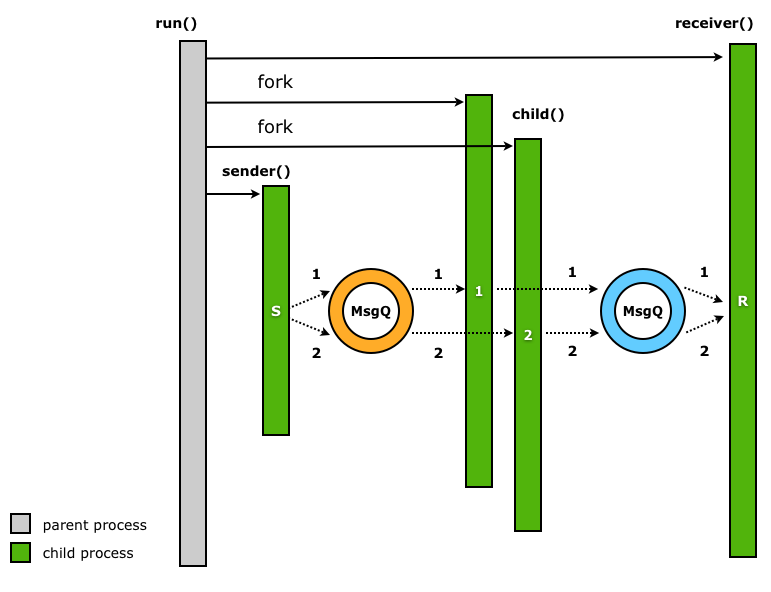This is an old revision of the document!
Developer documentation
A list of the options available in the hold version of run-tests and information about whether that are (or will be) re-implemented.
Introduction
runtests is a test environment written in PHP. It is used to tests PHP itself. It is not a replacement for unit test frameworks like PHPUnit.
The basic principle of automated tests is very simple. Compare a computed result with some pre-calculated “known good”, expected value. If both match, the test has passed. If they do not match, the tests failes, and there is probably a bug in PHP, or some precondition for the test was not met.
Testing PHP is a far more complex issue than it may seem at first glance, because each test may require an individual PHP configuration, certain settings at operting system level (for example environment variables), or even external services (like databases, LDAP servers or IMAP servers).
A test that requires external services can be complex to set up, but there is no way around that. How could you make sure that running a SQL statement against a database works without actually running it against a database?
Since a failing test will probably leave its environment in an unpredictable state, a high level of test isolation is required. In other words, this means that we need to set up a new preconfigured PHP process for each test. This is the only way to ensure that every test runs in a clean environment.
So, to execute each test, runtests must set up a PHP process, have it run the test, collect the output, and compare it to the pre-calculated “known good” expected output. That spawned PHP process (hopefully) terminates, so at the process level, we do not have to worry about the potential mess that a test has left behind. Still, if the test has created files, databases, or modified the global system environment, additional work may be required to clean up after the test.
Since PHP runs on most of the available platforms, runtests must also run on all these platforms. From an implementation point of view, this means that runtests must work on a minimal, stock PHP installation, and should make as few as possible assumptions on the system environment. All the more or less known cross-platform issues like different line endings, directory separators, case handling, as well as limits of different operating system families (file name path length, include path length) have to be taken into account and being dealt with in runtests.
Since runtests spawns off a separate PHP process to run a test, it is not necessary to run each test in the same PHP version that runtests runs on. In other words, that means that you can test a different PHP version than you are actually running - and in fact, it may be a good idea to use a “known good” PHP version to test a new, less tested PHP version. After all, bugs in the PHP version runtests itself is running on might affect runtests itself, and thus make the test results less reliable.
We have already mentioned that tests need an individual environment. Not all tests can be run at the command line, for example. If a test need to make sure that PHP returns correct HTTP header, or processes GET or POST input, the test probably requires the CGI SAPI to run.
Parallel Execution
Introduction
The parallel execution of the test cases is one of the main features of the new phpruntests. Compared to the previous run-tests script it allows to run the tests cases in about half the time. Here are a few data about the performance:
Before digging into the details there are a few issues to know:
Preconditions
Of course we need a few preconditions to perform the parallel test-execution:
- PCNTL installed: http://www.php.net/manual/en/book.pcntl.php
- *nix only – Currently we are not supporting windows platforms, because windows does not provide the same native possibilities for multiprocessing as unix does (mainly the fork routine). Therefore, our first goal was to focus on our main target audience and provide the parallel executions for unix only. The windows implementation is planned, however, as a subsequent step and will become a default feature of later phpruntests.
If these preconditions are not fulfilled, the tests are automatically executed sequentially.
Test-Groups
The test cases are stored across the whole php-folder, e.g.:
- ext/xml/tests/xml_set_external_entity_ref_handler_error.phpt
- Zend/tests/double_to_string.phpt
- tests/lang/script_tag.phpt
A major issue was how to deal with dependencies between the single test-cases. For example, the MySQL tests: One test creates a database table which is also used by a couple of other test cases. So we had to ensure to keep the order of the test cases while distributing them to different processes. For that reason we designed the test-group which are representing a directory that contains phpt-testfiles. With these groups, we are able to map the structure of the test directories to our program in order to distribute only complete test groups to the different processes, not just the single test-cases. The test-cases themselves are executed in alphabetical order, exactly as they are stored in the directory.
With this design, we are able to avoid test dependencies in a very simple, but also efficient manner. Of course that also means that there must not be any directory-comprehensive dependencies. In other words, if you are writing depending test cases, make sure that they are stored in the same directory, and that the alphabetical order meets your requirements.
TaskScheduler
This is place were the magic happens, this package handles the parallel execution in phpruntests. The required source files are stored in
http://svn.php.net/viewvc/php/phpruntests/trunk/src/taskScheduler/
First of all you have to know that the taskScheduler was implemented from a generic point of view with the goal to execute any various task an distribute it to a various number of processes. Here is the basic concept: A task, however it looks like, has a procedure which is executed and delivers a result afterwards. A list of such tasks is passed to the taskScheduler which executes them and provides the results.
You might be interested in what else is possible with the taskScheduler. If so, please have a look a the prototype code, including some examples:
http://svn.php.net/viewvc/php/phpruntests/trunk/code-examples/taskScheduler/
rtTask
In our case, this task procedure is implemented in rtTaskTestGroup. which represents a kind of a nutshell of a test-group. This class also extends the superclass “rtTask” and implements the “rtTaskInterface” to ensure that the required methods are available.
rtTaskScheduler
This is the main class of the scheduler-package which is responsible for handling the processes and the communication between them. Like in other phpuntests classes this class provides a factory-method (rtTaskScheduler::getInstance) for instancing the right subclass. This method implements a check if PCNTL is available. If so, an instance of rtTaskSchedulerFile is returned. Otherwise the basic is returned which provides sequential execution only.
The simple, sequential variation is also implemented in this superclass (rtTaskScheduler::run) and does nothing more than passing through the task-list in a simple loop, executing the test-groups and storing the results.
- taskList - array - a list of task-objects (extending rtTask, implementing rtTaskInterface)
- resultList - array - the result list in the same order as the taskList
- processCount - int - the number of processes (default=0). If the value is 0, the tasks are automatically executed sequentially.
- reportStatus - int - defines the detail-level of the output during the test execution (see verbose-mode)
rtTaskSchedulerFile
This class implements the common variation of parallel execution. The suffix “File” describes the way the IPC is handled. In this case that means the the processes are communicate only via temporary files which are stored on the disk.
The run-method overrides the superclass and forks the defined number of child processes and assigns a unique ID to them. The tasks (containing a group of test- ases) are distributed sequentially to those child-processes via a task-file. e.g. 5 tasks, 3 processes:
task A -> process 1
task B -> process 2
task C -> process 3
task D -> process 1
task E -> process 2
In detail, the whole task object is serialized and written to a temporary file. The filename is suffixed by the unique ID of the corresponding child process (e.g.: “TaskFile3”). The child reads the whole task file, splits off the single tasks and executes them. Afterwards it gets the result, which is an array of rtTestResult-Objects, serializes it and writes it back to its task-file. After executing all corresponding tasks, the child-process is terminating itself. In the meantime, the parent process is waiting until all children are finished and starts the receiver afterwards. The receiver is collecting the results from the task files and storing them to the result list in exactly the same order as the task list.
A brief look at the code shows that the tasks as well as the results are written to the file immediately (using FILE_APPEND) instead of collecting them first and write it only once. This maybe looks like a performance-leak, but it's absolutely necessary to avoid out-of-memory errors. The string of the collected serialized objects would become too large from a certain number of tasks.
As you can see, there are also two signal-handlers (SIGQUIT, SIGINT) registered. The associated method does only terminate the process with exit(0), but this is important to remove the temporary files in a case of interruption.
rtTaskSchedulerMsgQ
As above, the suffix “MsgQ” describes the implemented IPC-variation. All in all, this class does the same job as “rtTaskSchedulerFile” but uses message-queues instead of files to distribute the tasks and collect the results.
The run-method forks a sender, a receiver and the defined number of child processes which are responsible for executing the tasks. The sender passes through the task-list and writes the tasks to the the sender queue. The child-ID is set as the message-type, so every child process reads only its corresponding tasks and executes them. Afterwards, the child writes the results to the receiver-queue from where the receiver-process is collecting them.
The sender terminates if all tasks are distributed. When the receiver has collected all results, it sends a kill-signal to all child-processes via the input-queue and terminates itself. The parent-process is waiting for all children to finish and exits afterwards.
File or MsgQ?
Both implementations provide exactly the same functionality. The message-queue is maybe the more elegant one, but in fact it's another barrier on the way to the aimed platform-independence.
We choose the file variation as the common because it's a more flexible strategy when we start to think about platform-independence. Of course the usage of PCNTL makes it impossible to perform parallel-execution on non-unix platforms (see above), but this implementation could be a base to go about further improvements.
Of course we also compared the performance of these two implementations, the differences are absolutely disregarding. In some cases the file-IPC is even faster than the message-queue.
Verbose-mode (output)
As described above (see reportStatus), the taskScheduler is also responsible for the output during the test-execution. After executing a task, the child process passes the result to a static method of the outputWriter (rtTestOutputWriter::flushResult) which evaluates and flushes it to the console.
There are 3 levels of the verbose mode:
- -v test status and test file
- -vv same as above plus DESC and MSG about not-passed tests
- -vvv all available information:
Example
(1) XFAIL /phpruntests/trunk/QA/QATESTS/tests/output/ob_011 (2) DESC: output buffering – fatalism (3) MSG: This test will fail until the fix in version 1.178 of ext/main/output.c (4) CID: 5 (5) MEM: 1727.43 kB (6) FILES: out: /phpruntests/QA/QATESTS/tests/output/ob_011.out exp: /phpruntests/QA/QATESTS/tests/output/ob_011.exp diff: /phpruntests/QA/QATESTS/tests/output/ob_011.diff (7) PHP-COMMAND: /php/php53/sapi/cli/php -d "output_handler=" -d "open_basedir=" -d "safe_mode=0" -d "disable_functions=" -d "output_buffering=Off" -d "error_reporting=32767" -d "display_errors=1" -d "display_startup_errors=1" -d "log_errors=0" -d "html_errors=0" -d "track_errors=1" -d "report_memleaks=1" -d "report_zend_debug=0" -d "docref_root=" -d "docref_ext=.html" -d "error_prepend_string=" -d "error_append_string=" -d "auto_prepend_file=" -d "auto_append_file=" -d "magic_quotes_runtime=0" -d "ignore_repeated_errors=0" -d "unicode.runtime_encoding=ISO-8859-1" -d "unicode.script_encoding=UTF-8" -d "unicode.output_encoding=UTF-8" -d "unicode.from_error_mode=U_INVALID_SUBSTITUTE" -f /phpruntests/QA/QATESTS/tests/output/ob_011.php 2>&1
- teststatus and testcase
- description (--TEST--)
- message (optional)
- child-ID – the id of the execution child-process (see child)
- current memory-usage
- saved files
- executed php-command
Integration in phpruntests
The taskScheduler is connected to the phpruntests-application at one point, in rtPhpTestRun. After preparing the command line arguments and environment parameter,s this class is responsible for collecting and preparing the test-cases and of course for kicking off the test-execution itself. And this is how it looks like:
// create the task-list
$taskList = array();
foreach ($subDirectories as $subDirectory) {
$taskList[] = new rtTaskTestGroup($runConfiguration, $subDirectory);
}
Initially the list of the task-objects is created. Every task gets passed the configuration-object, which is needed to execute the test-cases and the directory where the test-cases (phpt-files) are stored.
// run the task-scheduler $scheduler = rtTaskScheduler::getInstance(); $scheduler->setTaskList($taskList); $scheduler->setProcessCount($processCount); $scheduler->setReportStatus($reportStatus); $scheduler->run(); $resultList = $scheduler->getResultList();
Subsequently a new instance of the taskScheduler is created to which the task-list is passed. Optionally the number of processes (processCount) and the verbose-level (reportStatus) can be defined. After running the taskScheduler the results are received and can be evaluated (this is the job of the outputWriter).



